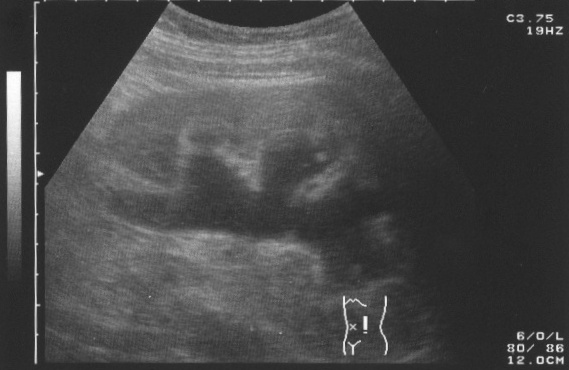Hydronephrosis: Difference between revisions
Jump to navigation
Jump to search
No edit summary |
No edit summary |
||
| (28 intermediate revisions by 5 users not shown) | |||
| Line 1: | Line 1: | ||
__NOTOC__ | |||
{{Infobox_Disease | | {{Infobox_Disease | | ||
Name = {{PAGENAME}} | | Name = {{PAGENAME}} | | ||
| Line 9: | Line 10: | ||
OMIM = | | OMIM = | | ||
MedlinePlus = | | MedlinePlus = | | ||
MeshID = D006869 | | MeshID = D006869 | | ||
}} | }} | ||
{{ | {{Hydronephrosis}} | ||
{{SCC}} | {{SCC}} | ||
'''Contributors:''' [[User:zorkun|Cafer Zorkun]] M.D., PhD;{{AE}}{{Vbe}} | |||
{{SK}} Obstructive nephropathy | |||
==[[Hydronephrosis overview|Overview]]== | |||
== | ==[[Hydronephrosis historical perspective|Historical Perspective]]== | ||
==[[Hydronephrosis classification|Classification]]== | |||
== | ==[[Hydronephrosis pathophysiology|Pathophysiology]]== | ||
==[[Hydronephrosis causes|Causes]]== | |||
==[[Hydronephrosis epidemiology and demographics|Epidemiology and Demographics]]== | |||
==[[Hydronephrosis risk factors|Risk Factors]]== | |||
==[[Hydronephrosis differential diagnosis|Differentiating Hydronephrosis from other Diseases]]== | |||
==[[Hydronephrosis natural history, complications and prognosis|Natural History, Complications and Prognosis]]== | |||
== | ==Diagnosis== | ||
[[Hydronephrosis history and symptoms|History and Symptoms]] | [[Hydronephrosis physical examination|Physical Examination]] | [[Hydronephrosis laboratory findings|Laboratory Findings]] | [[Hydronephrosis x ray|X Ray]] | [[Hydronephrosis CT|CT]] | [[Hydronephrosis MRI|MRI]] | [[Hydronephrosis ultrasound|Ultrasound]] | [[Hydronephrosis other imaging findings|Other Imaging Findings]] | [[Hydronephrosis other diagnostic studies|Other Diagnostic Studies]] | |||
==Treatment== | ==Treatment== | ||
[[Hydronephrosis medical therapy|Medical Therapy]] | [[Hydronephrosis surgery|Surgery]] | [[Hydronephrosis primary prevention|Primary Prevention]] | [[Hydronephrosis secondary prevention|Secondary Prevention]] | [[Hydronephrosis cost-effectiveness of therapy|Cost-Effectiveness of Therapy]] | [[Hydronephrosis future or investigational therapies|Future or Investigational Therapies]] | |||
==Case Studies== | |||
[[Hydronephrosis case study one|Case#1]] | |||
== | ==Related Chapters== | ||
*[[Urology]] | *[[Urology]] | ||
*[[Urinary tract]] | *[[Urinary tract]] | ||
{{Nephrology}} | {{Nephrology}} | ||
[[Category:Urology]] | [[Category:Urology]] | ||
Latest revision as of 14:13, 1 September 2018
| Hydronephrosis | |
 | |
|---|---|
| Ultrasound picture of hydronephrosis caused by a left ureteral stone | |
| ICD-10 | N13.0-N13.3 |
| ICD-9 | 591 |
| DiseasesDB | 6145 |
| MeSH | D006869 |
|
Hydronephrosis Microchapters |
|
Diagnosis |
|---|
|
Treatment |
|
Case Studies |
|
Hydronephrosis On the Web |
|
American Roentgen Ray Society Images of Hydronephrosis |
Steven C. Campbell, M.D., Ph.D. Contributors: Cafer Zorkun M.D., PhD;Associate Editor(s)-in-Chief: Vindhya BellamKonda, M.B.B.S [1]
Synonyms and keywords: Obstructive nephropathy
Overview
Historical Perspective
Classification
Pathophysiology
Causes
Epidemiology and Demographics
Risk Factors
Differentiating Hydronephrosis from other Diseases
Natural History, Complications and Prognosis
Diagnosis
History and Symptoms | Physical Examination | Laboratory Findings | X Ray | CT | MRI | Ultrasound | Other Imaging Findings | Other Diagnostic Studies
Treatment
Medical Therapy | Surgery | Primary Prevention | Secondary Prevention | Cost-Effectiveness of Therapy | Future or Investigational Therapies